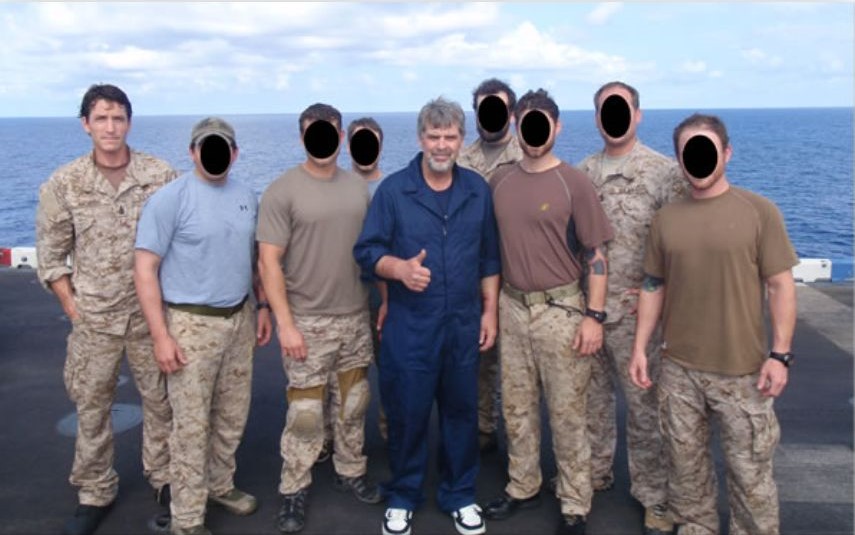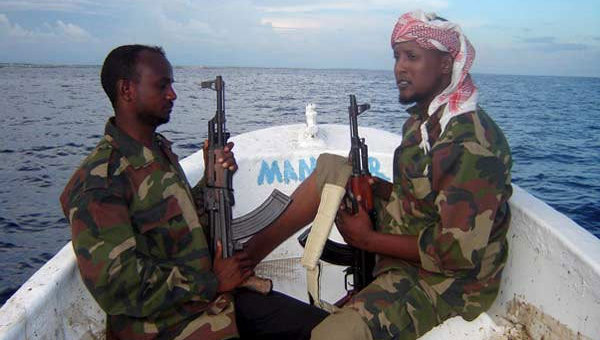Unknown to the pirates, the SEAL Snipers Infra Red (IR) lasers were trained on the three Somali pirates who would, within seconds, take their last breath in this life. The three shots fired by the snipers broke in simultaneous harmony. You could faintly hear the quiet, muffled sounds of the reports from the suppressed SR-25 weapons over the humming sound of the US warship. Three less pirates to worry about…..
The Setup: Responding to a Hostage Crisis
Fourteen hours prior to these shots, several highly trained SEAL snipers were mustering at a secret compound on the East Coast of the United States. They had responded within 30 minutes to a special encrypted text message alert. Not knowing the nature of the alert, they were now getting briefed on the situation. A US Shipping Captain, Richard Phillips of the Maersk Alabama, had been taken hostage hours ago aboard one of the Maersk’s lifeboats and was being held at gunpoint for ransom.
Somalia has long been a hotbed of piracy, and the trend is increasing into the new century. As you read this, dozens of ships lay off the coast, and huge sums of money are being negotiated for the release of both ships and crews.

Personally, I can’t help but think about what I would do if I were a young and able Somali lured by the vast riches of piracy that lie a short distance off the coast. Considering the average Somali earns $230USD a year I know what I would do.
Within minutes of their briefing, the snipers grabbed their pre-packed kit, including pre-loaded weapons, and rendezvoused with the C117 Globemaster. Within an hour of their alert, the SEALs were hurdling at over 400 knots halfway across the globe to shark-infested waters and the piracy capital of the world. The time sensitivity of the situation would mean they would go over final planning en route.
The plan: a low-level night parachute drop at 2500 feet over and into the warm murky waters off the North African coast. This insert is commonly referred to by operators as a “hop and pop”. Afterward, they would link up with a small boat from the US Destroyer ship on station and immediately go to work.
While we operate on land, air, and sea, like our SBS brothers across the Atlantic, SEALs own the maritime environment. You have very few takers when you add rough, cold seas to the equation. We don’t just work in this environment; we live for it and embrace the misery because we know our adversaries will never see us coming.
Basic Underwater Demolition/SEAL training, or BUD/S, is grueling. Men who successfully complete training are forged into physically and mentally tough individuals. They emerge from the icy furnace of the Pacific Ocean, born again hard. Seven out of ten candidates drop out of the intense seven-month selection course. Serious work requires serious selection. Other US special operations forces will often compare themselves to SEALs, but in the quiet of the night when they reflect personally, they admit to themselves that their selection is no comparison. Any that argue so just have to look at the length of training and attrition rate to realize that it is like comparing a London Business school MBA to one earned online. Enough said.
The ramp lowers, and the five-minute signal is passed to the jumpers. Warm air rushes in and fills the dark cargo bay of the plane and embraces each man. The SEALs stand, fully kitted up and ready to jump in the dim night vision compatible lighting of the cargo hold. Final checks are complete. One minute, green light, go.
The team dives head first in concert off the ramp. The plane crew chief watches as the team disappears into the night, and he wonders what it would be like to jump into darkness and into the sea.

The team parachutes down with the aid of night vision. Within minutes of the jump, they plunge into the womb of the Indian Ocean. Home again, they work quickly to make communications for their link up and within minutes they are met in the dark, picked up and setting up on the US Destroyer.
Into the Night: The SEALs’ High-Stakes Operation
At this time, the pirates are hungry and fatigued with no idea that they are one step closer to period end.
The hostage situation is escalating in the world media, and the US administration is under increased pressure to rescue Captain Phillips. The SEALs on board know how this game will end and wait quietly for the word. While politicians worry about how the situation will affect their future in politics, serious men stand by, knowing that there can only be a serious resolution.
At this point, US intelligence has learned the names of the pirates. They start hailing them over megaphone and one of the pirates jumps, surrendering. Captain Phillips also attempts to escape, but is hastily reigned in by his captors.
In an attempt to gain more intelligence and ensure the Captain remains healthy, the Somali pirates are offered food and water.

The SEALs disguise themselves as regular Navy to get a better look at the situation and assess the hostage’s physical and mental condition. They catch a quick glance of the captain and secretly film the scene with hidden cameras to review and study later. The pirates are nervous, and the SEALs break contact before any of the young pirates lose their nerve and cracks off a nervous round on the trigger of their AK47.
The lifeboat runs out of gas and the pirates appear more nervous and distracted by the enormity of a situation they could never imagine. The day passes with anticipation and more stalling by the administration. The on scene commander is worried they are drifting within close range of another known Somali piracy clan’s backyard. They offer to tow the pirates ashore and proceed to tow them back out to sea.
The Final Countdown: Precision and Execution
The SEAL on scene commander finally receives authority and rules of engagement (ROE’s) to take out the pirates if Captain Phillips’ life is in danger. “About time” he thinks to himself. What the pirates don’t know, is that snipers are hidden in position and are ready and willing to take their lives in a moments notice.
The sun goes down on the Indian Ocean and paints an eerie orange glow on the horizon before slipping away and bringing still darkness. It would be the last sunset these three pirates would live to see.
The SEAL commander gives the signal to the sniper teams and heads below decks for a cup of strong navy coffee. Most of the crew steers clear of him, and some notice how calm and collected he looks. It’s obvious he has seen more hardship in his few years than most of the crew would see in a lifetime. As he sips his coffee, he thinks about home, his family, and the complexity of the situation. He realizes how lucky he is to have been born a world away to different circumstances. He knows that it could be him in that boat in another lifetime.
The snipers have a quick conversation over inter-squad radios and quietly choreograph the shots that will soon end three lives. Once over the radio, and each of them rehearses their shot multiple times in their minds. Visualizing is one of the critical components of mental management, learned and honed to perfection in training. They are incapable of anything other than flawless execution of the shot. SEAL snipers don’t miss.
In a few seconds that seem like hours, the pirates emerge from the hot, stuffy cabin of the lifeboat. They breathe in the fresh air, but all three still remain nervous as they feel the fast beat of the hearts pounding like prayer circle drums in their chests. They have no idea that three lasers are trained on their heads, invisible to them, and only visible in the infrared spectrum. They look at each other with uncertainty as Captain Phillips reflects on his own life. Phillips thinks he’s a dead man. He’s seen the nervous looks of these young men and knows that his life hangs by a thread.
The lifeboat gently rocks back and forth while the lasers dance along in rhythm with the sea. Philips is clear of the targets. That’s what the pirates have become at this point: no longer humans; They are rationalized in the sniper’s mind as targets.
The sniper team leader has ensured that the bullet path is clear behind Phillips. The snipers have to make sure that when the bullet enters the target and leaves out the back, the path is clear. The team leader gives the countdown, “shot in 3-2-1”. Whoosh, whoosh, whoosh, the three shots are unleashed in harmonious unison. The suppressed bullets leave the sniper’s rifles at over 2000 feet per second and rush toward the green dot faster than the speed of sound.

In seconds, the situation has been handled with finality. The pirates did not suffer because they were shot with precision. It is a quick, clean death, unlike what most of us will encounter in this life.
The SEALs will remain nameless and likely not receive formal recognition. Those who know this work also know that it’s about doing the job, not the recognition. The team immediately packs their kit and prepares to go home as silent professionals, until the next call….
Brandon
—
Disclaimer: SOFREP utilizes AI for image generation and article research. Occasionally, it’s like handing a chimpanzee the keys to your liquor cabinet. It’s not always perfect and if a mistake is made, we own up to it full stop. In a world where information comes at us in tidal waves, it is an important tool that helps us sift through the brass for live rounds.










COMMENTS
You must become a subscriber or login to view or post comments on this article.